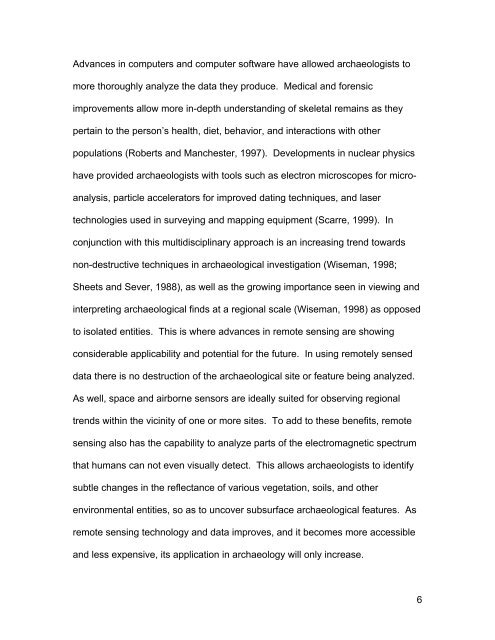A Review of Remote Sensing Application in Archaeological Research
A Review of Remote Sensing Application in Archaeological Research
A Review of Remote Sensing Application in Archaeological Research
Create successful ePaper yourself
Turn your PDF publications into a flip-book with our unique Google optimized e-Paper software.
Advances <strong>in</strong> computers and computer s<strong>of</strong>tware have allowed archaeologists to<br />
more thoroughly analyze the data they produce. Medical and forensic<br />
improvements allow more <strong>in</strong>-depth understand<strong>in</strong>g <strong>of</strong> skeletal rema<strong>in</strong>s as they<br />
perta<strong>in</strong> to the person’s health, diet, behavior, and <strong>in</strong>teractions with other<br />
populations (Roberts and Manchester, 1997). Developments <strong>in</strong> nuclear physics<br />
have provided archaeologists with tools such as electron microscopes for microanalysis,<br />
particle accelerators for improved dat<strong>in</strong>g techniques, and laser<br />
technologies used <strong>in</strong> survey<strong>in</strong>g and mapp<strong>in</strong>g equipment (Scarre, 1999). In<br />
conjunction with this multidiscipl<strong>in</strong>ary approach is an <strong>in</strong>creas<strong>in</strong>g trend towards<br />
non-destructive techniques <strong>in</strong> archaeological <strong>in</strong>vestigation (Wiseman, 1998;<br />
Sheets and Sever, 1988), as well as the grow<strong>in</strong>g importance seen <strong>in</strong> view<strong>in</strong>g and<br />
<strong>in</strong>terpret<strong>in</strong>g archaeological f<strong>in</strong>ds at a regional scale (Wiseman, 1998) as opposed<br />
to isolated entities. This is where advances <strong>in</strong> remote sens<strong>in</strong>g are show<strong>in</strong>g<br />
considerable applicability and potential for the future. In us<strong>in</strong>g remotely sensed<br />
data there is no destruction <strong>of</strong> the archaeological site or feature be<strong>in</strong>g analyzed.<br />
As well, space and airborne sensors are ideally suited for observ<strong>in</strong>g regional<br />
trends with<strong>in</strong> the vic<strong>in</strong>ity <strong>of</strong> one or more sites. To add to these benefits, remote<br />
sens<strong>in</strong>g also has the capability to analyze parts <strong>of</strong> the electromagnetic spectrum<br />
that humans can not even visually detect. This allows archaeologists to identify<br />
subtle changes <strong>in</strong> the reflectance <strong>of</strong> various vegetation, soils, and other<br />
environmental entities, so as to uncover subsurface archaeological features. As<br />
remote sens<strong>in</strong>g technology and data improves, and it becomes more accessible<br />
and less expensive, its application <strong>in</strong> archaeology will only <strong>in</strong>crease.<br />
6
















